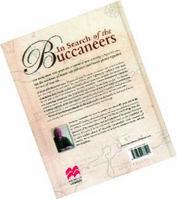Paddy Dalton, Contributor
If you enjoy a history book that combines well-known and little-known facts, myths and romance, legendary villains and heroes and a dose of historical speculation, In Search of the Buccaneers by Anthony Gambrill (Macmillan Caribbean, 2007) is sure to bring history to life for you.
The book introduces the reader to the origin of the boucanier with an early chapter dramatically illustrated by a Swedish artist, Gote Goransson. In the early l600s, when the Spanish withdrew from north-western Hispaniola, part of Haiti today, this Caribbean frontier attracted a hard breed of woodsman prepared to make a life for himself hunting wild pigs and cattle abandoned by the Spanish settlers.
The name boucanier derived from the boucan, or grill, over which they smoke-cured their meat to preserve it, collecting animal fat for tallow which, along with skins, they traded for their other necessities.
The boucaniers thrived as a society of men whose dependence on each other (they adopted a remarkable code of conduct) and marksmanship skills served them well when living off the land was no longer a viable occupation.
Having an understandable antipathy for the Spanish who relentlessly tried to drive them out of Hispaniola, the buccaneers took to hunting them at sea.
Alexander Esquemelin, the most famous chronicler of the buccaneers' exploits, suggests that a French pirate, Pierre le Grand, set the example when he captured a rich Spanish galleon. With 28 men in a barely-seaworthy vessel he approached the stern of the galleon in near-darkness, bored a hole in the bottom of his boat to scuttle it and led his desperadoes, armed only with pistols and cutlasses, onto the deck to overwhelm a terrified crew. This is only one of many interesting escapades described in detail in the book.
According to the author, the Haitian island of La Tortue, known in English history as Tortuga, was the birthplace of buccaneering. From l630 it repeatedly changed hands between the French, English and Spanish.
'Legitimising' piracy
It was with the capture of Jamaica in l655 by General Venables and Admiral Penn that the ranksof the boucaniers, soon anglicised to buccaneers, grew to include adventurers, fugitives and misfits of all nationalities. Their opportunity arrived when the English authorities at Port Royal realised they needed help to deter Spain from trying to retake the island.
Deciding that attack was the best defence, the Governor of Jamaica, Lord Windsor, authorised a pre-emptory attack on Santiago de Cuba by legally commissioning the buccaneers of Tortuga to join the fledgling colony's forces along with the remnants of Venables's army. This tactic of 'legitimising' piracy was also to be employed by the French and Dutch governors for the next 40 years in the Caribbean.
Within a decade, Port Royal emerged as the place where buccaneering came of age.
Readers begin to meet the many characters who glamorised the era. These include Rock Brasiliano, who reputedly roasted his captives on a spit to extract information; the prostitute known as the German Princess and Henry Morgan, whose exploits were the stuff of legends. In the book, Port Royal is colourfully described revealing how it got its "wickedest city" reputation.
In the nine chapters that follow, the author focuses on those places that the most notorious French, Dutch and English buccaneers carried out reprisals against the Spanish, the exception being St. Eustatius where the latter launched an abortive attempt to drive the Dutch out of the region.
Each of these chapters encapsulates the early history of the cities the buccaneers ravaged. Portobelo and Vera Cruz were the warehouses for the treasure fleets of Spain; Providencia, a small island off the coast of Nicaragua, was strategically important as it was on the route between these two destinations.
Granada, the inland capital of Nicaragua, was considered inviolable until the buccaneers resourcefully found their way up the San Juan River. Campeche, not so much a rich target lay near to the profitable dyewood trade. Perhaps the best known of the buccaneers' campaigns was against Panama when Morgan led 2000 men across the isthmus to the Pacific coast to sack the jewel of Spain's colonial empire. It was here, as myth would have it, that he unsuccessfully wooed a very beautiful Spanish senora.
The last campaign in which the buccaneers were engaged took place in l697 when Louis XIV employed the buccaneers to capture Cartagena. However, by this time they were becoming a liability to the now-established European colonies and the legitimised pirates could no longer obtain the commissions that they needed.
In Search of the Buccaneers contains l40 illustrations, paintings, maps and photographs, and for the traveller with a liking for history the book describes what still exists today from the l7th century in each destination.
Categorised as a 'popular history' (with no lengthy footnotes), this book provides a satisfying read for anyone interested in the heritage of the Caribbean.

